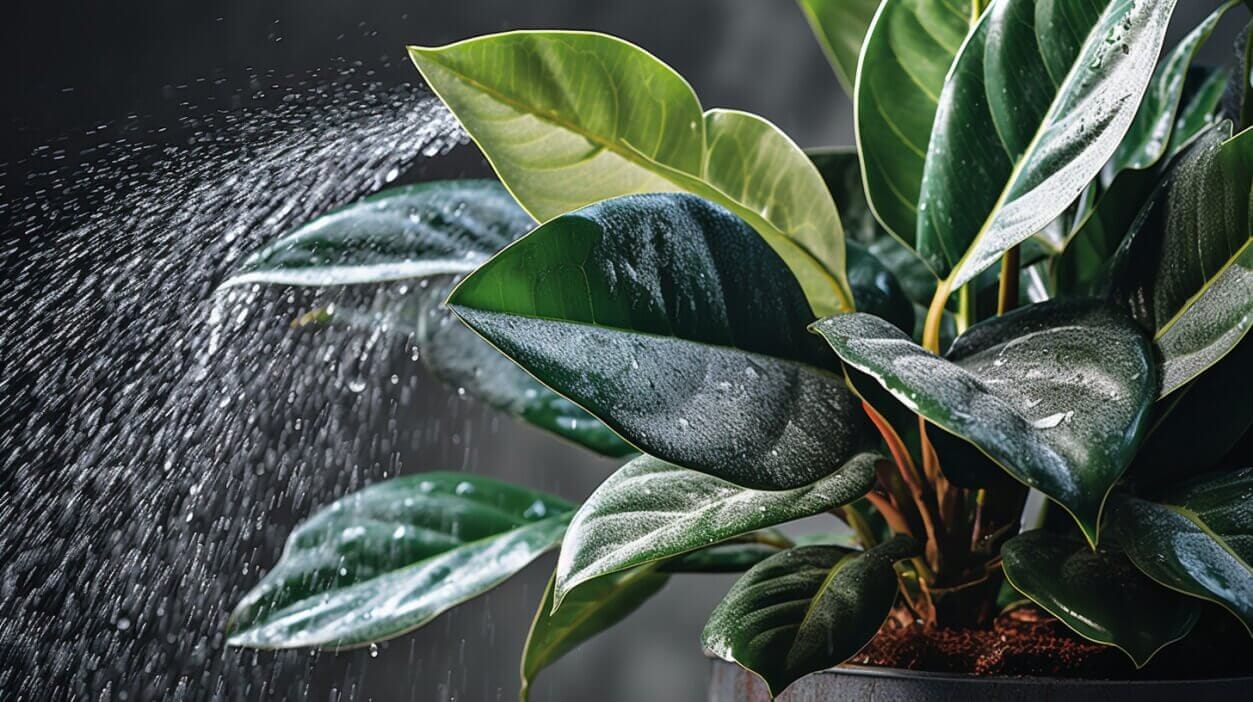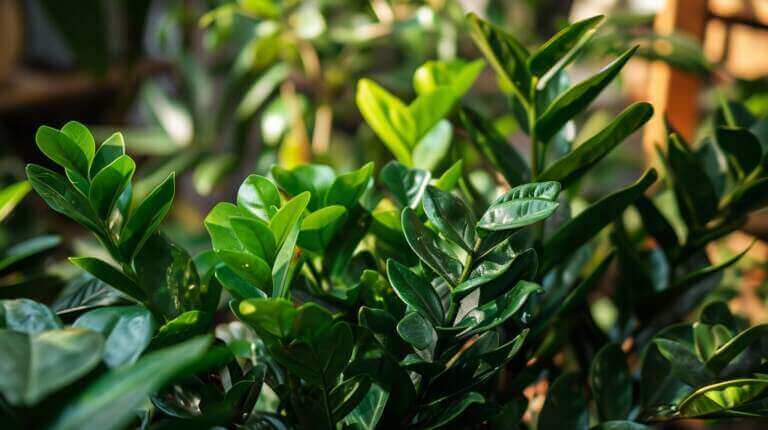Key Takeaways:
- Rubber plants are tropical plants that don’t like soggy soil, so they should only be watered once the top layer of soil has dried out.
- The frequency of watering depends on factors like the plant’s size, type of soil, humidity levels, season, etc. Smaller plants may only need water every 7-10 days, while larger plants may need water every 4-5 days.
- During the warmer and sunnier months, rubber plants need more frequent watering. In the winter, water less often since growth slows.
- Check if the plant needs water by sticking a finger in the soil. Water if the top 1-2 inches are dry. Water thoroughly until water drains from the drainage holes.
- Tap water or distilled water work well for rubber plants. Let tap water sit out overnight before using to remove chemicals.
- Signs of underwatering include drooping, wrinkled, or curling leaves. Overwatering can lead to yellow leaves, root rot, moldy soil, or foul odors.
- To avoid overwatering, make sure the pot has drainage holes and do not let the plant sit in water. Pour out any water that collects in the saucer.
- Repotting into a larger pot or fast growth may increase the plant’s water needs. Newly repotted plants may need more frequent watering.
- Proper watering is key to keeping a rubber plant healthy and thriving indoors. Adjust the watering frequency based on the plant’s needs.
Understanding Rubber Plant Watering Requirements
Factors affecting the watering needs of rubber tree plants
When it comes to how often to water rubber plant, there are a few key factors to consider. First and foremost is the type of soil your plant is potted in. Rubber trees thrive in well-draining soil, so make sure the pot has proper drainage holes to prevent waterlogging. The size of your plant and the pot it’s in also play a role in determining watering frequency. Smaller plants in smaller pots will need less water compared to larger plants in bigger pots.
The environment your rubber plant is in is another important factor. If your plant is in a location with bright, direct sunlight, it may require more frequent watering to compensate for the increased evaporation. On the other hand, if your plant is in a darker corner with low light levels, it may need less water as it won’t be going through as much evaporation.
Optimal moisture levels and signs of overwatering
The key to watering your rubber plant is finding the right balance. Aim for soil that is consistently moist, but not overly wet. Stick your finger about an inch into the soil – if it feels dry, it’s time to water.
Overwatering can be detrimental to your rubber plant’s health. Signs of too much moisture or overwatering include yellowing leaves, drooping stems, and root rot. If you notice these signs, it’s best to cut back on watering and allow the soil to dry out before watering again.
How Often to Water Rubber Tree Plants
Weekly watering schedule for rubber tree plants
I absolutely adore my rubber tree plant and want to make sure it stays healthy and thriving. One of the most important aspects of caring for a rubber tree plant is providing it with the right amount of water. So, how often should you water your rubber tree plant?
A general rule of thumb is to water your rubber tree plant once a week. This ensures that the soil remains moist without becoming waterlogged. Overwatering can lead to root rot, while underwatering can cause the leaves to wilt and drop. To check if your plant needs water, simply stick your finger into the soil up to the knuckle. If the soil feels dry at that depth, it’s time to water.
Adjusting watering frequency based on seasons and environmental conditions
While a weekly watering schedule is a good starting point, it’s important to adjust the frequency based on the seasons and environmental conditions. During the warmer months, when the plant is actively growing, you may need to water it more frequently. However, during the colder months, when the plant goes into a dormant phase, you may need to reduce the watering frequency.
In addition to seasonal changes, you should also consider the humidity levels in your home. If you live in a dry climate, you may need to water your rubber tree plant more often to compensate for the lack of moisture in the air.
By observing the moisture level of the soil, considering the season and environmental conditions, and adjusting the watering frequency accordingly, you can ensure that your rubber tree plant receives the right amount of water for healthy growth.
How Much Water Rubber Tree Plant Needs? – Checking Moisture Levels
Hey there, fellow plant lovers! If you’re wondering how much water your rubber plant needs and how often to water it for healthy growth, let’s dive right in!
Using a water meter to measure moisture levels in the soil
To determine when to water your rubber plant, a handy tool to have is a water meter. These meters can be easily inserted into the soil, providing accurate readings of the moisture levels. Simply stick the probe into the soil, making sure it reaches the root zone. If the meter shows that moisture is low, it’s time to water your plant. If it indicates high moisture levels, then it’s best to hold off on watering.
Alternative methods for checking soil moisture
Don’t have a water meter? No worries! There are alternative methods you can use to check the moisture levels in the soil. One technique is the finger test. Simply poke your finger about an inch or two beneath the surface. If the soil feels dry, it’s time to water. Another method is using a wooden skewer. Insert it into the soil and remove it after a few minutes. If the skewer comes out dry, give your rubber plant a drink.
Signs of Overwatering a Rubber plant and Underwatering
Recognizing signs of underwatering in rubber tree plants
As a proud owner of a beautiful rubber plant, it’s essential to understand the water requirements of your leafy friend to ensure healthy growth. Underwatering can have a negative impact, so it’s crucial to recognize the signs. Some common indicators of underwatering in rubber tree plants include dry soil, wilting leaves, and leaf drop. If you notice these signs, your plant need more water. Be sure to water your rubber plant thoroughly
Identifying symptoms of overwatering and taking corrective measures
While it’s important not to underwater your rubber plant, overwatering can be equally harmful. Overwatered rubber tree plants may show signs such as yellowing leaves, root rot, and a musty smell coming from the soil. If you suspect overwatering, it’s crucial to take corrective measures promptly. Ensure that the pot has proper drainage and allow the soil to dry out before watering again. Adjusting your watering schedule and being mindful of the plant’s moisture needs will promote healthy growth.
Paying attention to your plant’s specific needs and reacting to any signs of underwatering or overwatering will help you maintain a thriving rubber tree plant. So keep an eye out for these signs, and your rubber plant will thank you with lush, vibrant leaves.
Best Practices for Watering a Rubber Tree Plants
Proper techniques for watering rubber tree plants
When it comes to watering your rubber tree plants, it’s important to strike the right balance. Overwatering can lead to root rot, while underwatering can cause the leaves to wilt and drop. Here are some guidelines to ensure you’re providing your rubber tree plant with the water it needs:
- Check the top inch of soil: Before watering, stick your finger into the soil about an inch deep. If it feels dry, it’s time to water. If it’s still moist, wait a few more days and check again.
- Water thoroughly: When you do water, make sure to thoroughly saturate the soil until water comes out of the drainage holes. This ensures that the roots receive an adequate amount of water.
- Allow for proper drainage: Make sure your rubber tree plant is in a pot with drainage holes. This allows excess water to escape and prevents the roots from sitting in water for too long.
Tips for maintaining consistent moisture levels in the soil
To ensure healthy growth and prevent water-related issues, here are some tips for maintaining consistent moisture levels in the soil:
- Establish a watering schedule: Develop a regular watering routine based on the plant’s needs and environmental conditions. This helps maintain a consistent level of moisture in the soil.
- Monitor humidity: Rubber tree plants thrive in higher humidity environments. Consider using a humidifier or placing a water tray near the plant to increase humidity levels.
- Use a moisture meter: If you’re unsure about the moisture level in the soil, use a moisture meter to accurately gauge when it’s time to water.
FAQs – Best Way To Water Ficus Elastica
How can I tell if my rubber plant needs water?
Here are some signs to tell if your rubber plant needs water:
- The top few inches of soil are dry when you check by inserting your finger. If the soil is dry beneath the surface, it’s time to water.
- Leaves start to droop or wrinkle slightly. Drooping leaves that perk up after watering indicate the plant was thirsty.
- Leaves feel less firm or rubbery and begin to feel soft or pliable. Healthy rubber plant leaves should be fairly rigid.
- New growth and leaf margins turn brown. Underwatering can lead to crispy edges.
- Leaf color looks paler or less vibrant. Proper hydration keeps leaves looking lush.
- Soil pulls away from the sides of the pot. This signals the soil has dried and shrunk.
- Pot feels very light when lifted. A pot that feels drastically lighter indicates dry soil.
Get to know your plant’s signs of thirst. Checking soil dryness and leaf firmness are good ways to gauge if your rubber plant needs a good soak.
What do I need to consider when watering rubber tree as a beginner?
Here are some key things to consider when watering a rubber tree plant:
- Allow the top few inches of soil to dry out before watering again. Use your finger to check moisture.
- Water thoroughly until water drains freely from the drainage holes when you do water.
- Always water until water comes through the drainage holes to ensure the entire root zone is hydrated.
- Pour water slowly and evenly around the base of the plant, not just in one spot.
- Only water as frequently as needed based on your plant’s requirements and growing conditions. Don’t stick to a fixed schedule.
- Use room temperature water, as extremely cold or hot water can shock the roots.
- Keep an eye on humidity levels which impact soil drying time. Boost humidity if needed.
- Check that the pot has adequate drainage holes so excess moisture can escape.
- Water less frequently in winter when growth has slowed.
Paying attention to your specific plant’s needs, checking soil moisture, and watering thoroughly but only when required will keep your rubber tree thriving.
Can you use tap water for indoor rubber tree plant?
Using tap water for indoor rubber plants is generally fine, but there are a few things to keep in mind:
- Let tap water sit out uncovered overnight before using it. This allows chlorine and fluoride to dissipate, which can build up and damage the foliage over time.
- During the winter when humidity is low, adding a water softener to the tap water can help prevent leaf tip burn.
- If your tap water has high mineral content, using filtered or distilled water is better to prevent salt buildup.
- Monitor the plant’s reaction. If you see signs of leaf scorching or crisping, switch to filtered water or water that has been left out overnight.
- Keep the potting soil slightly acidic, around 6.0-6.5 pH, as rubber plants are sensitive to alkaline water.
- Wiping leaves regularly helps prevent mineral residue buildup from tap water.
So in most cases, tap water is fine for watering rubber plants. Just take some precautions like letting it sit out or using a water softener. Pay attention to the plant’s response and make adjustments if its foliage shows distress.
How much water do rubber tree need water?
Rubber plants need to be watered when the top inch of soil feels dry. The exact amount of water will vary depending on factors such as the size of the plant, the pot size, and the temperature and humidity of the environment.
What type of water is best for rubber plant?
Rubber plants prefer water that is free from chemicals such as chlorine and fluoride. Using filtered or distilled water is recommended to prevent the build-up of minerals in the soil.
How do I water my rubber tree plant?
To water a rubber plant, pour water slowly and evenly into the pot until it starts draining out of the bottom. Allow the excess water to fully drain before placing the plant back in its tray or decorative pot.
How often should you water a rubber plant?
Rubber tree plants should be watered when the top inch of soil feels dry. This usually translates to watering the plant every 7-10 days, but it’s important to adjust the frequency depending on the plant’s water needs and environmental conditions.
What should I consider when watering my rubber tree?
When watering a rubber tree, take into account factors such as the plant’s size, the pot size, the temperature and humidity of the environment, and the soil type. These factors will help determine the watering needs of the plant.
How much water does a rubber plant need?
Rubber plants require enough water to keep the soil evenly moist but not waterlogged. Avoid letting the plant sit in standing water as it can lead to root rot.







